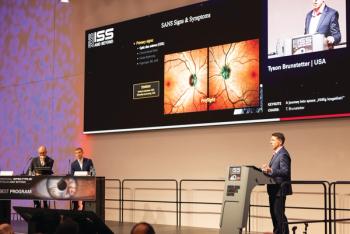
Facing challenge of corneal infection management in operated eyes
Early identification, aggressive treatment critical; when to consider surgical intervention
Corneal infections involving surgical interfaces and incisions represent high-stakes situations. Bennie H. Jeng, MD, MS discusses diagnosis and management of these challenging situations.
Reviewed by Bennie H. Jeng, MD, MS
Corneal infections involving surgical interfaces and incisions represent special situations that mandate special considerations for successful management, said
“There is a high risk for progressive infection and/ or wound dehiscence in these clinical situations,” he said. “Early identification and aggressive treatment of the infection are critical, and surgical intervention might also need to be considered.”
Penetrating keratoplasty
The inflammatory response accompanying an infectious corneal ulcer in an eye that has had penetrating keratoplasty (PK) can cause endothelial cell dysfunction and subsequently graft failure. Infection can also develop around loose sutures and lead to graft loss secondary to tissue destruction or graft dehiscence.
Use of topical corticosteroids, presence of eyelid/ adnexal abnormalities or epithelial defects, and bandage contact lens wear can also lead to late infection in eyes with a full thickness graft. Management of corneal infections in post-PK eyes includes obtaining a specimen for culture, aggressive treatment with fortified antibiotics, and consideration for reduction in topical corticosteroid use. Suture removal is needed in cases involving suture abscess.
“If the infection is large and progressive, threatening the graft-host interface, I will try to excise it en bloc and regraft the cornea if it is not responding to medical therapy appropriately,” Dr. Jeng said.
Infections that develop in a Descemet stripping automated endothelial keratoplasty or Descemet’s membrane endothelial keratoplasty interface tend to appear a few weeks to a few months after the graft procedure and usually have a fungal etiology, with Candida being the most common pathogen. In addition to the clinical appearance, confocal microscopy can be helpful for making the diagnosis. Excision of the donor lenticule and surrounding infected tissue followed by PK provides definitive treatment, but alternative management approaches have also been described.
The latter include removing the endothelial graft, irrigating the anterior chamber with amphotericin B, and then repeating the endothelial keratoplasty procedure after the infection has been adequately treated. Intrastromal injections of antifungal agents have also been suggested.
“These infections are deep-seated, and topical and oral antifungals are not very effective treatments because they do not penetrate to the infection site when administered by these routes,” Dr. Jeng said. Infections in a deep anterior lamellar keratoplasty (DALK) interface are also most often caused by fungi.
Bacterial infections can also occur and usually develop in the setting of incomplete removal of infected stroma when the grafting was performed in an eye with active infectious keratitis. Confocal microscopy can aid in the diagnosis, and PK represents the most definitive treatment. Intrastromal injection of an antimicrobial agent can also be considered.
As for interface infections in endothelial keratoplasty (EK), infections in the DALK interface are deep-seated, and as such, topical and oral therapies are not usually adequate. “Irrigation of the interface after graft removal will probably not be effective because there will still be infected stromal tissue,” Dr. Jeng said.Using keratoprosthesis
When a corneal infection develops in an eye with a keratoprosthesis, there is special concern that it will progress to involve tissue underneath the collar of the device where penetration of topically applied antimicrobial agents will be poor.
There is a risk that the infection will migrate along the stem of the optic into the eye, causing endophthalmitis. Management requires scraping to obtain a specimen for culture and smear with attention to trying to scrape underneath the device’s flange if there is involvement in that area.
Topical fortified antibiotics and antifungals should be administered. Corneal crosslinking is being investigated as a possible treatment for these infections.
“I would not hesitate to remove the keratoprosthesis and perform PK if I was concerned about perforation, endophthalmitis, or spread toward the graft-host interface,” Dr. Jeng said.
Implantation of another keratoprosthesis can be considered only after the eye has become quiet. Infections in a LASIK interface that develop within the first 1 to 2 weeks after surgery are usually caused by gram-positive bacteria, whereas atypical microorganisms (especially Mycobacteria but also fungi) are the common causes of infections appearing later.
LASIK interface
Because LASIK interface infections are superficial, they can be managed by lifting, scraping, and irrigating the flap. Considering the risk for mycobacterial infection, material obtained for Gram stain and culture in eyes with a late infection should be cultured on Lowenstein-Jensen media, in addition to standard media, Dr. Jeng said.
Patients with a LASIK interface infection should also be started on fortified antibiotic drops, and a topical fluoroquinolone might be added. In cases with late presentation where there is concern about an atypical pathogen, treatment should include amikacin and discontinuation of topical corticosteroids. For fungal infections, preferred agents are natamycin or voriconazole if the organism is a filamentous fungus while amphotericin B is used for yeast infections. “Intervention in the worst-case scenario would be to do a therapeutic PK,” Dr. Jeng said.
Incision infections after cataract surgery generally present within the first week and can be caused by bacteria, fungi, or atypical mycobacteria. These infections are abscess-like and recommended management involves incision and scraping for culture, done in a minor room or operating room. Intensive topical antimicrobial treatment and possibly intrastromal administration of antimicrobials is indicated.
“If the infection is extending to the limbus, I would not hesitate to do an early lamellar excision if it will remove the involved tissue,” he said. “If it is too late, then the involved tissue can be removed and replaced with a small full-thickness graft.”
Disclosures:
Bennie Jeng, MD, MS
E: [email protected]
This article was adapted from Dr. Jeng’s presentation at Cornea Subspecialty Day during AAO 2018. Dr. Jeng has no relevant financial interests to disclose.
Newsletter
Get the essential updates shaping the future of pharma manufacturing and compliance—subscribe today to Pharmaceutical Technology and never miss a breakthrough.







































